Root Chervil (Chaerophyllum bulbosum)
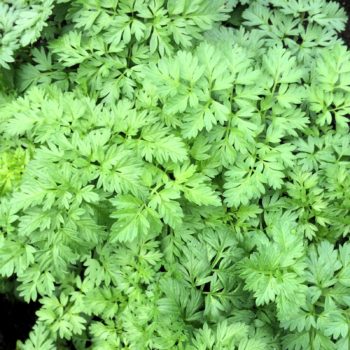
Overview
- Root chervil is a minor European root crop, probably best known in France.
- This crop is easy to grow in the Pacific Northwest and in much of the northern US.
- Root are small, typically two to three inches long, but rarely as long as five inches.
- Plants produce a single tap root, just like carrot or parsnip.
- The roots have a flavor that is like a combination of carrot and parsnip or is sometimes described as similar to chestnut.
- Roots must be stored under cold conditions for about a month to develop full flavor.
- The foliage is also edible and tastes similar to parsley.
- Plants are biennial, producing a root in the first year and flowering in the second year.
- Plants are started from seed and the seeds require cold stratification in order to germinate.
About Root Chervil
Description
Root chervil or turnip rooted chervil (Chaerophyllum bulbosum) is a member of the family Apiaceae, along with the herb chervil, carrots, parsnips, celery, and many other edible plants (in this book, arracacha and skirret). It has never been a particularly popular crop, although it was more commonly grown in the past than it is today. “Turnip rooted” chervil is probably a misnomer, which is why I have settled on just calling it root chervil; roots do not reach the size of a turnip unless your turnips are very disappointing.
Root chervil is considered a challenging plant to grow, but many of the challenges are created by lack of information, something that I hope to correct in this chapter. There are two key pieces of information necessary to grow and enjoy root chervil:
- The seeds require stratification before you sow them.
- The roots require a storage period before you eat them.
If you ignore either of these requirements, you will not enjoy growing root chervil.
Root chervil is a biennial plant, forming a storage root in the first year and then going to seed in the second year. Plants grow to about four feet (1.2 m) tall and the structure will be familiar to anyone who has seen carrots or parsnips in flower.
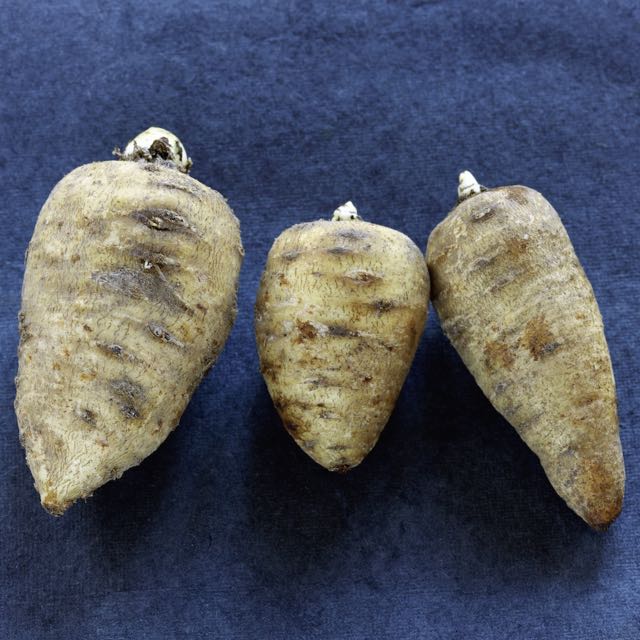
The root is fairly small, typically reaching two or three inches (5 to 7.5 cm) in length and perhaps half that in width. Size probably accounts for its decline in popularity, since yields are small compared to similar plants like carrot or parsnip that have much larger roots. Nevertheless, I think that root chervil is worth growing, as it has a unique flavor. Flavor is always a subjective experience, but I find root chervil particularly difficult to describe. It is something like the flavor of a carrot, with the texture of a baking potato but a bit firmer, perhaps more like a chestnut, with an aftertaste of the herb chervil.
The roots taste best after several weeks of storage or after a freeze (if you can leave them in the ground that long). You can reproduce this effect by storing the roots for a few weeks in the vegetable crisper of your refrigerator. As with most root vegetables, it is easily prepared by boiling or roasting. It is not generally (ever?) eaten raw.
There is a subspecies, Chaerophyllum bulbosum ssp. prescotii, that is native to Siberia. It is said to be larger but with an inferior flavor (Facciola 1998). I have never tried it, for lack of seeds.
History
The origin of root chervil’s domestication appears to be uncertain, at least to the few authors who have addressed the subject in English. The center of domestication is probably somewhere in eastern Europe. Although root chervil is now somewhat popular in France, it was popular earlier in Germany and Austria. It may never have been more than a wild collected food though.
Root chervil was introduced to Britain in 1726 as an ornamental and grown on a large scale for a time (Hickmott 2003). It was introduced to France in 1846 and a breeding program was started in 1985 that has produced several new varieties (Peron 1990).
Wild populations still exist in Europe and diversity within and between those populations appears to be high (Le Clerc 2014).
Nutrition
Root chervil has a surprisingly low water content for a root vegetable: sixty percent. In comparison, carrots generally have 85% or more water content and parsnips 75% or more. This will give you some idea of the dryness of the flesh of root chervil.
At harvest, the root is about 25% carbohydrate, of which 15% is sucrose (thus the root is relatively sweet) and 8% starch (Peron 1990). Once the root has entered dormancy, it begins to exchange starches for sugars. This occurs most rapidly at cold temperatures, but any period of storage will sweeten the roots and improve their food quality.
Cooking and Eating
Roots must go through a period of cool storage before they are worth eating (Ayala Garay 2003). This can be done by leaving them in the ground until after the first frosts or by keeping them in the refrigerator or another cool, humid location. Many people complain that the roots are bland and hard when freshly harvested, which is true.
Roots stored at 40° F (4 C) sweeten sufficiently for eating in one month and those stored at 50° F (10 C) require two months, while roots stored at higher temperatures may not reach a sweet enough stage before their quality declines (Ayala Garay 2003).
The roots are traditionally boiled, steamed, or used in purees, and peeling them is said to ruin the flavor (Facciola 1998). They also roast well, particularly accompanying fatty meats like waterfowl. I didn’t notice much of a flavor difference in peeled roots, but they are already small, so peeling seems wasteful.
New shoots and leaves are also edible and have a bit of chervil like flavor. They quickly become fibrous and bitter as they grow.
Cultivation
Climate Tolerance
Root chervil is widespread in Europe, where it grows in riverine environments from Turkey in the south to Finland in the north. It requires moist soil and prefers cool temperatures. It seems also to benefit from high humidity. If the soil dries out, the plant will either become dormant or bolt to seed and will not produce a good root in either case. If you are growing root chervil in a dry climate, water regularly.
The plant is generally considered to be hardy to USDA zone 5, but I haven’t found an original source for this information and haven’t tested it myself. Given the plant’s distribution in Europe, the zone information is probably correct; it grows as far north as Finland.
Photoperiod
Root chervil has no photoperiod requirements. What a relief!
Soil Requirements
Plant in the same sort of soil that you would use for carrots or parsnips. Well draining, sandy loam with a near neutral pH is ideal. As with many root crops, it is difficult to balance fertility sufficient for good top growth against the low levels necessary for good root growth. Rich soil causes thin, forking, and hairy roots. It is better to err on the side of underfeeding than overfeeding. I enrich the bed with thoroughly composted manure, but provide no other fertilization.
Propagule Care
Root chervil seed life is similar to parsnip. It drops off significantly after the first year, although you can still get a small percentage to germinate in later years. Seed stores longer in the freezer. Many of the people who report poor results with root chervil are probably using stale seed.
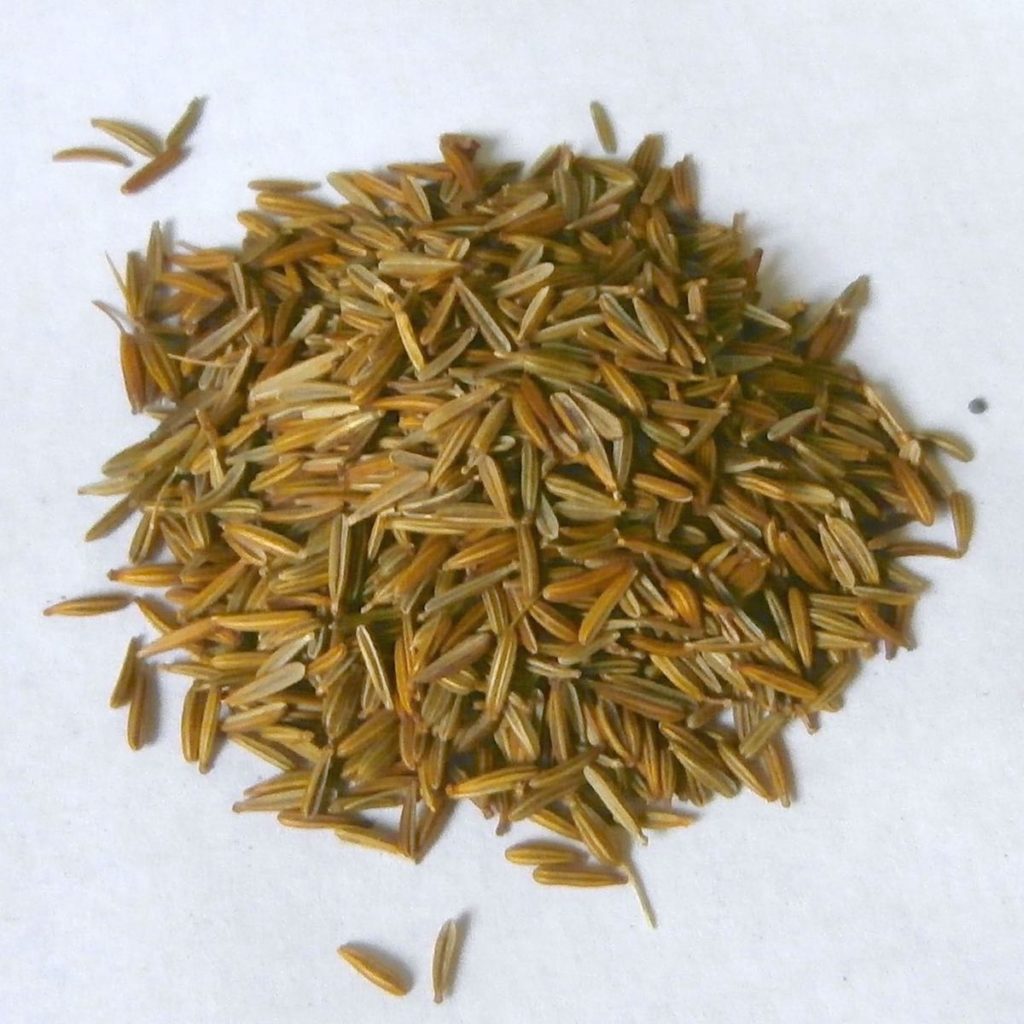
That said, I think that quite a bit of the failure that is attributed to short storage life is the result of failure to stratify properly and pests eating the seeds in outdoor sowing. I have sown seed as old as four years and obtained about 30% germination. That’s not good, but it also isn’t bad considering the large number of seeds that the plants produce.
Planting
Root chervil takes about five months to produce a crop. Germination is best in cool weather, but the root really needs to be frosted in the field in order to develop its best flavor. So, you have two choices: you can stratify the seed in the refrigerator and sow it in early summer or you can sow the seed outdoors in the winter and put the roots in cold storage after harvesting in summer.
You can also try the minimum effort course of sowing in winter and leaving the mature plants in place until after cold weather has arrived. The only problem is that you may lose your crop to pests while it sits in the field. If you want to try this, mulch over the roots and wait until cool weather has done its work on them. The mulch will protect the roots from high summer temperatures which can break them out of dormancy. If you harvest before frosts arrive, remember that you need to store them in the refrigerator for about a month before they are at their best.
Root chervil has an inconvenient combination of poor and uneven germination, hard dormancy, and short seed life. A 75% germination rate is very good, even from fresh seed. 50% is probably more typical. The easiest way to start seeds is to sow them in a protected seed bed in early winter and just leave them until they sprout in spring. Obviously, there are downsides to this, as birds and mice may eat your seed. In addition, results aren’t that good in really wet climates, probably because the seeds rot. If you have snow cover in the winter, this is probably your best option.
Otherwise, you should cold stratify in the refrigerator for thirty to ninety days before planting in the spring. The longer the stratification time, the better the germination appears to be, although I often fail to get them started in time for a 90 day stratification.
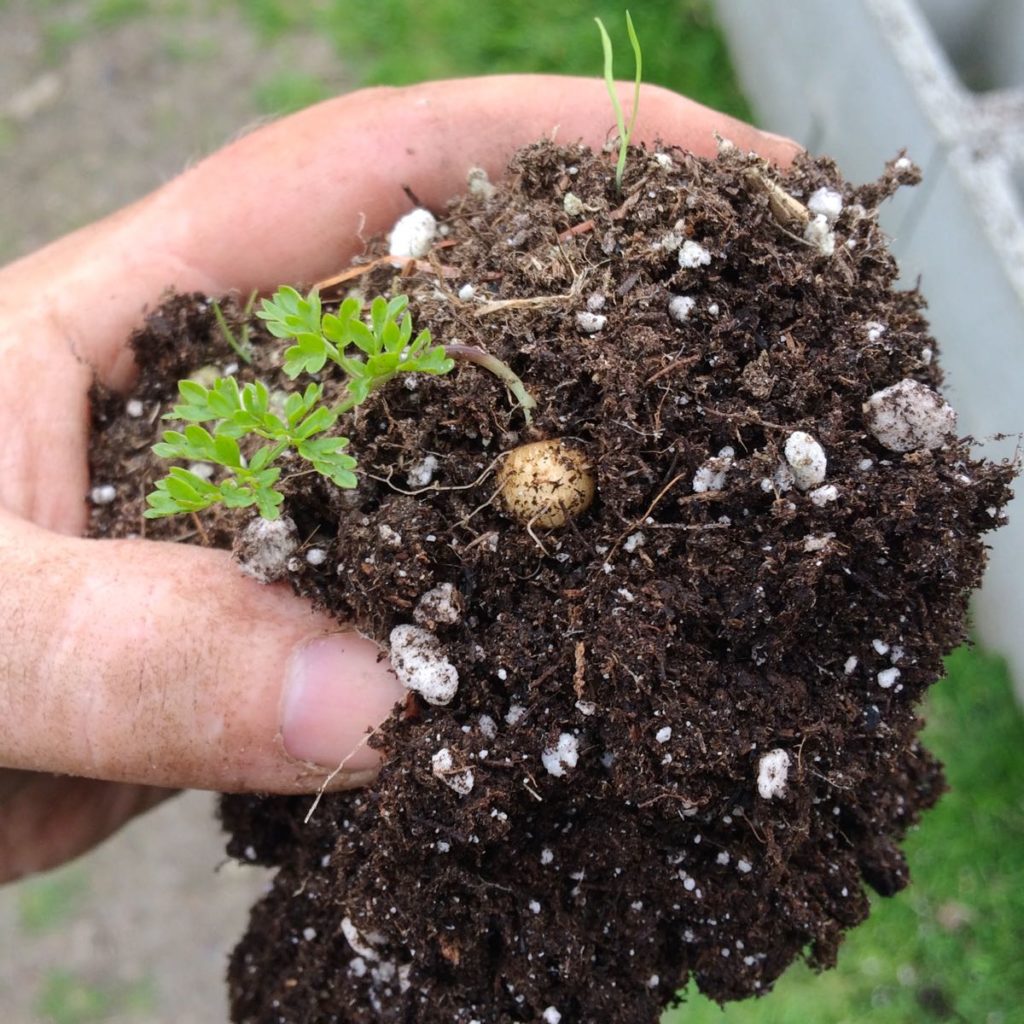
Here is the stratification method that I use:
- Soak two cups of potting soil (roughly) in room temperature water.
- Squeeze the soil to eliminate excess moisture and put it in about a one quart, resealable plastic bag or container.
- Add your seeds and mix thoroughly.
- Put the container somewhere warm (about 70° F, 21C) for two weeks.
- Put the container in the refrigerator for at least four weeks. Eight is better and twelve is best.
After that, the seed is ready to sow. Just scatter the seed and potting soil mix on the ground and then rake in lightly. Germination tricks used with carrots, parsnips, and parsley can all be helpful. Thin to at most one plant per four inches (10 cm) of row.
If you have only a little seed and need to maximize it, you can grow the seedlings in pots and transplant with reasonably good success until they reach about three inches (7.5 cm) in height. Past that point, they grow poorly after transplanting.
Management
Root chervil really only needs one thing from you: make sure the soil never dries out. Drip irrigation is highly recommended. As soon as the soil dries out, the plants will go dormant and that is as large as the roots will get.
The plant flowers in its second year, or occasionally in its first year. Plants that flower in their first year produce poor quality roots, so you should not save seed from those plants. In the second year, they are woody and inedible.
I have noticed apparent symptoms of phytophotodermatitis after extended periods of weeding around root chervil. I have found no other references that support this, but many plants in the family Apiaceae are capable of causing this condition. You might want to wear gloves and long sleeves when working around this plant.
Companion Planting
I haven’t experimented with companion planting for root chervil. It tends to do best in its own patch, where it can seed freely.
Growing as a Perennial
Root chervil is a biennial and there is nothing that you can do to make it last longer than two years. That said, the plants can be cultivated in a perennial patch, by allowing them to drop their seeds. This may be the best way to grow root chervil, since it avoids the complexity of seed storage and stratification. There are some problems with this strategy, though: disease may accumulate over time and lack of selection for good root characteristics may result in a gradual decline in root size.
Container Growing
Root chervil can be grown in containers of 1 gallon (4 l) or larger, but it would take several containers to produce enough for a meal.
Harvest
Plants usually reach full size and enter dormancy between June and August when planted in March. Planting in February may produce a better result if the soil is workable. In cooler years here, they finish in August and the roots are larger. Harvest promptly if you have problems with voles; this is another root crop that they love.
Storage
Trim the stems from the roots and store in a single layer at 38 to 45° F (3 to 7 C). The roots are ready to eat after about three weeks of storage and they will last for up to three months before quality is badly degraded.
Preservation
I know of no traditional or modern methods for the preservation of root chervil. Given its high dry matter content, it can probably be sliced and dried, but I haven’t tried it.
Propagation
Vegetative Propagation
Root chervil is one of the few plants in this book that has no easy routes to vegetative propagation. You can do it with supplemental hormones or in tissue culture, but it will only be worth the effort if you have very specialized needs.
Sexual Propagation
I recommend saving seed as you would do for carrots or parsnips. Harvest all the roots, then replant the best for your seed crop, keeping twenty plants as a bare minimum. Twenty plants will give you a large amount of seed and you should try to save from a larger number of plants when you grow from those seeds. 50 to 100 would be ideal. Plants in the family Apiaceae tend to suffer from inbreeding depression and saving seed from a larger number of plants helps to avoid this.
Root chervil is diploid. That’s a good thing, since it doesn’t have a convenient means of vegetative propagation. All sources of root chervil seed in North America appear to be some sort of mix, hybrid, or landrace, but it should be possible to select true breeding lines with a little work.
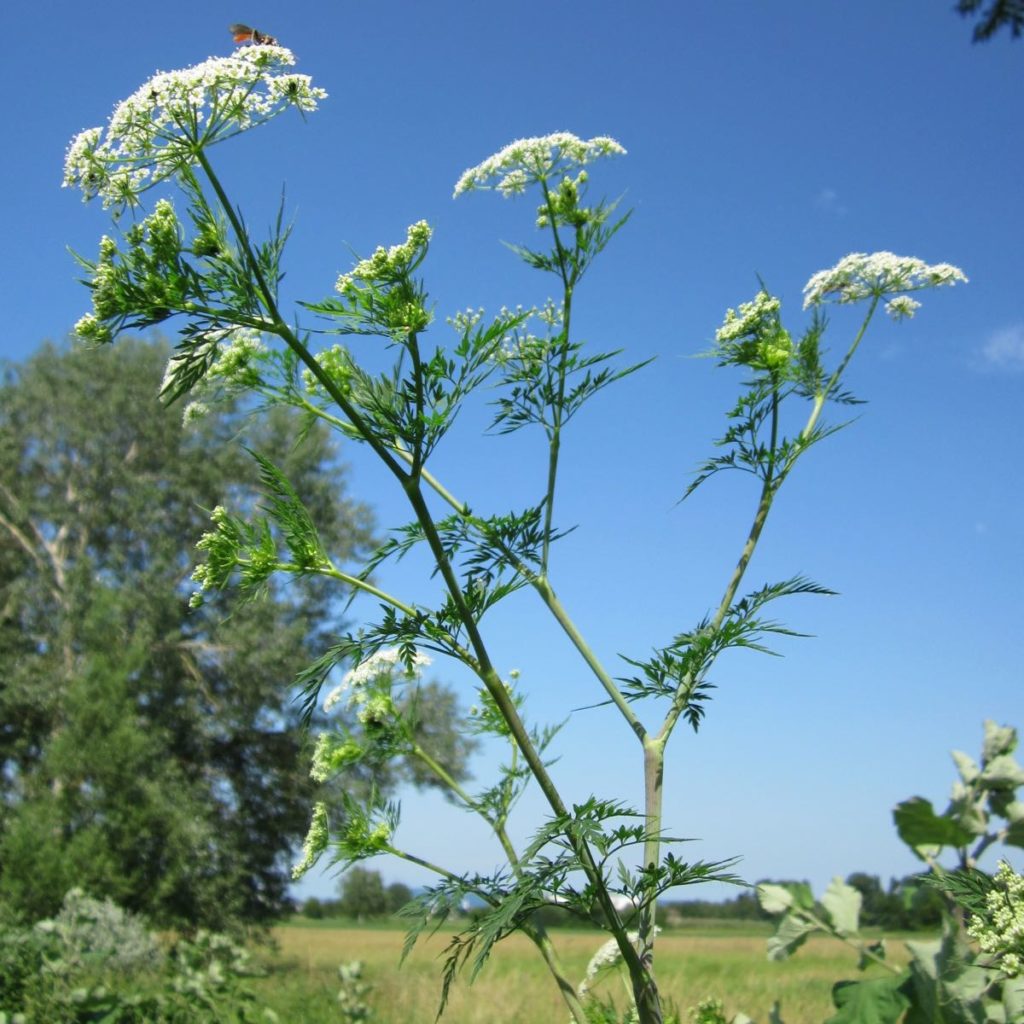
Root chervil flowers are initially hermaphroditic, but the outer flowers in an umbel are all male; ultimately, about 80% of the flowers are functionally male (Reuther 2013). Seeds are formed primarily in the oldest flowers, at the centers of umbels. The flowers are protandrous: hermaphrodites that first develop male structures and then female. The male flowers are technically hermaphroditic, but the female structures never develop. This makes root chervil functionally an outbreeder; although self pollination is not rejected, it is unlikely, since the male and female flowers develop at different times.
Flies and beetles appear to be the most active pollinators. I rarely see bees visiting root chervil.
Problems
Pests
Our arch nemesis, the vole, loves to eat root chervil even long before they have sweetened. The only solution is to harvest promptly and sweeten the roots in storage.
I have observed tiny seed feeding beetles working the flower heads in large numbers in some years. These can be a real pain if you are trying to save seeds from particular plants for breeding. Dusting the flowers with diatomaceous earth may help, but this also risks harming pollinators.
Diseases
I have seen no indications of disease in root chervil and there is little information available in the literature, but it is probably susceptible to some of the diseases that infect other cultivated members of the Apiaceae, such as carrots and parsnips.
Defects
Some of the plants bolt to seed in their first year; these should be culled. If you save seed from them, you will probably get more of this behavior in future generations.
Crop Development
This is an easy one. First, larger roots. Plants of similar size in the same family like carrots and parsnips have been bred to have much better root size. This suggests that breeding for larger roots should be possible, although my progress with this has been very slow, so far.
Breeding out the tendency to bolt in the first year would be a good idea. Not only do the bolters reduce the total yield of edible roots, but they threaten to spread inferior plants as weeds if they are not pulled from the field quickly enough.
Finding a way to reduce or eliminate the storage requirement might be nice, although this actually might make the crop less compatible for large scale growing. Breeders spend a lot of effort on other crops trying to make them survive longer storage. Root chervil would like nothing better than to be trucked around in a refrigerated container.
8 thoughts on “Root Chervil (Chaerophyllum bulbosum)”
Leave a Reply
You must be logged in to post a comment.

Thanks for the article. Very helpful. Harvested some roots today that were second year storage roots on a triennial pattern — perhaps caused by my transplanting of the thinned first-year plants which interrupted growth (or perhaps as you suggest too little water). I will try a deep mulch next year to try to get larger first-year roots and also a nursery bed of closely spaced plants to grow smaller tubers to use like onion sets to produce larger second-year roots on a triennial cycle. Also, I found myself eating the young second-year plants in stir-fries. They are pretty strongly flavored, so a little goes a long way. I added a post today on this to @veggie.garden.vermont.
Can root chervil be grown in the southern USA in Zone 8?
It should grow fine, but prolonged hot weather can result in fibrous and unappealing roots.
Do you think they would do/grow well when multi-sown?
https://charlesdowding.co.uk/multisowing/
Crowding is generally not desirable with root vegetables. On the other hand, root chervil tends to have low and irregular germination, so you might get a better stand that way. You could try a little of that and regular sowing to see which works better.
Bill, you should try and see if you cant get hold of the variety “Doleane”.
Doleane is the name given to “M4.10” in this study: https://pdfs.semanticscholar.org/fa66/c85d9675b7ca390b4a06bf298f96236fb6c9.pdf?_ga=2.179458212.1211753079.1591443260-870776317.1591443260
I have some, but it proved to be a little tricky to grow, because the seed doesn’t require chilling. When sown in the fall with the rest of my varieties, it germinated just a few weeks later.
Seed was difficult to find but i finally got some– it came all the way from Serbia! I only got about a dozen plants, using the methods outlined in this article. I garden in a short season high elevation location with cool temps so they were very tasty, harvested in November. I hope the remaining plants overwinter so i can get seed next year. However, I was disappointed that the roots i dug were branched instead of single. Do you know of a seed source so i dont have to spend years selecting for single, ‘large’ roots.